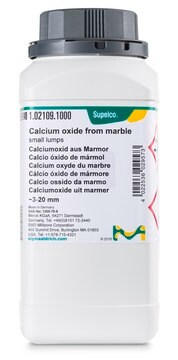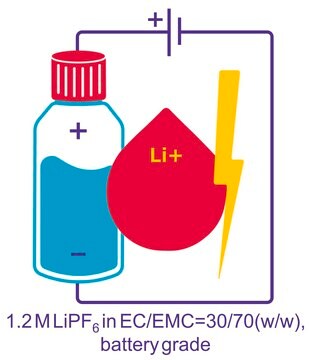05-0900
Calcium oxide
SAJ first grade, ≥98.0%
Synonym(s):
Lime, Quicklime
Sign Into View Organizational & Contract Pricing
All Photos(1)
About This Item
Linear Formula:
CaO
CAS Number:
Molecular Weight:
56.08
EC Number:
MDL number:
UNSPSC Code:
12352303
PubChem Substance ID:
Recommended Products
grade
SAJ first grade
Assay
≥98.0%
form
solid
reaction suitability
reagent type: catalyst
core: calcium
availability
available only in Japan
pH
12.6 (20)
bp
2850 °C (lit.)
density
3.3 g/mL at 25 °C (lit.)
SMILES string
O=[Ca]
InChI
1S/Ca.O
InChI key
ODINCKMPIJJUCX-UHFFFAOYSA-N
Looking for similar products? Visit Product Comparison Guide
Related Categories
Signal Word
Danger
Hazard Statements
Precautionary Statements
Hazard Classifications
Eye Dam. 1 - Skin Irrit. 2 - STOT SE 3
Target Organs
Respiratory system
Storage Class Code
11 - Combustible Solids
WGK
WGK 1
Flash Point(F)
does not flash
Flash Point(C)
does not flash
Personal Protective Equipment
dust mask type N95 (US), Eyeshields, Gloves
Choose from one of the most recent versions:
Already Own This Product?
Find documentation for the products that you have recently purchased in the Document Library.
Marco Faustini et al.
Nanoscale, 5(3), 984-990 (2012-12-19)
We report the simple preparation of ultra-thin self-assembled nanoperforated titanium calcium oxide films and their use as reactive nanomasks for selective dry etching of silicon. This novel reactive nanomask is composed of TiO(2) in which up to 50% of Ti
E Belon et al.
The Science of the total environment, 439, 87-95 (2012-10-16)
The inputs of ten trace elements (As, Cd, Cu, Cr, Hg, Mo, Ni, Pb, Se, Zn) to French agricultural soils have been assessed. The six main sources considered were: pesticides, mineral fertilizers, animal manure, liming materials, sludge and composts and
Mohammad Mahdi Najafpour et al.
Dalton transactions (Cambridge, England : 2003), 42(14), 5085-5091 (2013-02-12)
Inspired by Nature's catalyst, a nano-size layered manganese-calcium oxide showed a low overvoltage for water oxidation in acidic solutions, which is comparable to platinum.
Mahsa Naghshineh et al.
Food chemistry, 136(2), 472-478 (2012-11-06)
The application of high hydrostatic pressure technology for enzymatic extraction of pectin was evaluated. Cellulase and xylanase under five different combinations (cellulase/xylanase: 50/0, 50/25, 50/50, 25/50, and 0/50 U/g lime peel) at ambient pressure, 100 and 200 MPa were used
Vasilije Manovic et al.
Environmental science & technology, 46(22), 12720-12725 (2012-10-24)
This paper presents a novel method for reactivation of spent CaO-based sorbents from calcium looping (CaL) cycles for CO(2) capture. A spent Cadomin limestone-derived sorbent sample from a pilot-scale fluidized bed (FBC) CaL reactor is used for reactivation. The calcined
Our team of scientists has experience in all areas of research including Life Science, Material Science, Chemical Synthesis, Chromatography, Analytical and many others.
Contact Technical Service






